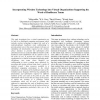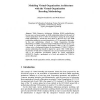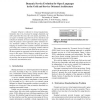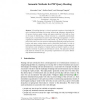116
Voted
PERCOM
2006
ACM
2006
ACM
Incorporating Wireless Technology into Virtual Organizations Supporting the Work of Healthcare Teams
15 years 21 days ago
This study investigates how a virtual organization can be built in a distributed computing environment which includes wireless technology to support the work of a multi-disciplina...
100
click to vote
ESWA
2008
15 years 25 days ago
2008
Resources in virtual organizations are classified based on their local taxonomies. However, heterogeneity between these taxonomies is a serious problem for efficient cooperation p...
100
Voted
ATAL
2010
Springer
15 years 1 months ago
2010
Springer
This paper describes the THOMAS framework, a useful framework for the development of virtual organizations, on the basis of a service-based approach. Categories and Subject Descri...
107
Voted
ICIS
1998
15 years 2 months ago
1998
This paper describes the design of groupware for virtual organizations that share certain characteristics. First the concept of virtual organizations is introduced. Then our appli...
92
Voted
DAIS
2007
15 years 2 months ago
2007
The present emergence of loosely-coupled, inter-enterprise collaboration, i.e., virtual organizations calls for new kind of middleware: generic, common facilities for managing cont...
CSCWD
2006
Springer
15 years 4 months ago
2006
Springer
The ability to construct dynamic, flexible virtual organizations becomes one of the most desired features of a distributed application system. This paper proposes an agent-mediated...
127
Voted
ATAL
2007
Springer
15 years 4 months ago
2007
Springer
Norm-governed virtual organizations define, govern and facilitate coordinated resource sharing and problem solving in societies of agents. With an explicit account of norms, openn...
85
Voted
IFIP
2009
Springer
15 years 5 months ago
2009
Springer
While Enterprise Architecture Modeling (EAM) methodologies become more and more popular, an EAM methodology tailored to the needs of virtual organizations (VO) is still to be devel...
113
click to vote
GRID
2004
Springer
15 years 6 months ago
2004
Springer
Dynamic behavior is inherent in virtual organizations. Semantics has to be processed to manage dynamism and other properties like state, life cycle, faults, and others. In our pap...
107
click to vote
MATES
2005
Springer
15 years 6 months ago
2005
Springer
Knowledge sharing in a virtual organization requires a knowledge life cycle including knowledge provisioning, terminology alignment, determination of resource location, query routi...




